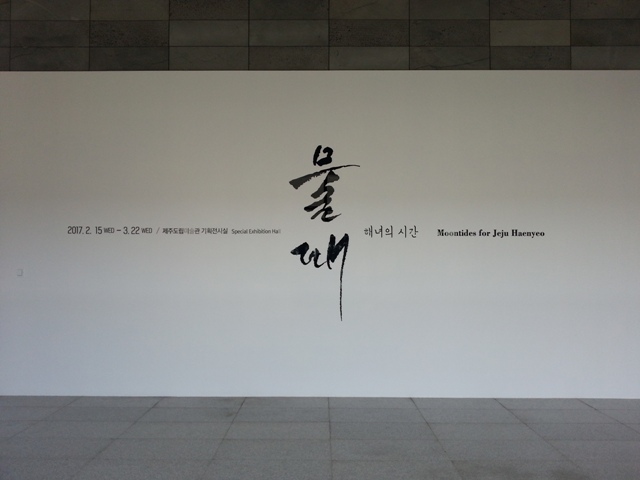| |
 |
|
| ▲ Moon Tides, for Jeju Haenyeo Photo courtesy The Jeju Weekly |
“Moon Tides, for Jeju Haenyeo” is open from Feb. 15 to Mar. 22 at the Jeju Museum of Art.
The paintings, installations, and photographs at this exhibition centre around the theme of the haenyeo - Jeju’s well known traditional women divers. These artworks represent the labours of a wide variety of artists who have spent years working closely alongside these amazing women.
A haenyeo’s life is all about waiting for the best time to dive, watching the tide, the wind, and the waves. This ebb and flow of the ocean’s many moods is described by the term “multtae” or lunar tides.
Many haenyeo don’t enjoy a consistently good night’s sleep because of their deep tidal connections. As Haenyeo Ko (born in 1928) put it, we “wake up in a flash from a short sleep…to see if the moon has set, or the stars have fallen.”
This exhibition attempts to bring you closer to the essence of this tension, to shed light on the experiences, values, and shared meaning of haenyeo communities.
Starting counterclockwise from the right side of the Special Exhibition Hall, we find two almost life-sized paintings of Grandma Ko Hyosaeng of Dongbok-ri, Gujwa-eup.
| |
 |
|
| ▲ Lee Jong-gu's Grandma Ko Hyosaeng Photo courtesy Jeju Museum of Art |
The paintings are so realistic that you can almost feel Grandma Ko’s presence and hear the water dripping from her “tewak” (a floating device attached to a net). Portrayals of her back and front, respectively, indicate her journey out to sea and her return from it.
Right from the start, you can feel that life isn’t easy for the her, as evidenced in the lines that time and tide have etched into Grandma Ko’s face.
The most impressive installation has got to be Kim Soon-im’s “Dancing Work-Clothes III”. A black rubber wetsuit used by the haenyeo during diving is suspended in midair with arms outstretched, a web of wire and feathers extending from the back.
| |
 |
|
| ▲ Kim Soon-im's Dancing Work-Clothes III Photo courtesy The Jeju Weekly |
The figure looks like a haenyeo with wings, floating in the totality of her domain, free from the patriarchal weight of Korean society.
Yet at the same time, she seems tied down by a tangle of responsibilities and difficulties. The haenyeo have always been marketed to tourists as quintessentially strong, independent women, and yet this art speaks directly to the collision of our expectations with reality. Strength and independence also come at a cost.
Nearby, Lee Ji-hyun’s “Dreaming Clothes”, showcases 21 cotton diving outfits that haenyeo used in the past before there were wetsuits. The artist destroyed the clothes and then restored them. The outfits were retooled as “visual objects through the process of ...dismantling them with a hammer."
| |
 |
|
| ▲ Lee Ji-hyun’s Dreaming Clothes Photo courtesy The Jeju Weekly |
There is nothing fancy about these cotton diving suits. However, seeing them hanging there, they enjoy something elegant and timeless. They look like items of fashion rather than just plain working clothes. A woven window through which we can see the past, the poignant struggles, and the perseverance of formidable women.
Positioned below an overhanging aluminium boat, and surrounded by their shadows on the walls, these cotton outfits look like artefacts at the bottom of the sea, quietly waiting to be uncovered by a curious posterity.
Further inside the Special Exhibition Hall are a whole range of watercolour paintings, oil paintings, acrylic paintings, video installations, and photographs.
The haenyeo are depicted smiling or exhausted after diving. They are shown diving for conch underwater and warming themselves up at a “bulteok” (a fireplace and changing room for warming up after diving as well as the social space).
These women are a special breed. Their lives are difficult, their working conditions extreme. But they survive. As an old haenyeo proverb goes, “We swim to the Otherworld to save money and return to the earthly world to save our kids”.
Their unique ways and their robust spirits have earned these women a rightful place on UNESCO’s Representative List of the Intangible Cultural Heritage of Humanity. However, their lives - like this exhibition - asks a much deeper question:
How can we preserve their way of life if we don’t also preserve the qualities that they embody? Mutual support, community, a respect for nature, and a never-say-die tenacity?
The Jeju Museum of Art opens daily from 9 AM to 6 PM and closes every Monday. Tickets are 1,000 won each for adults and 300 won each for children. |























